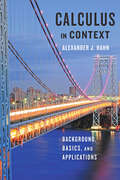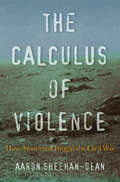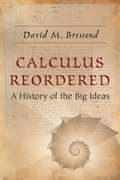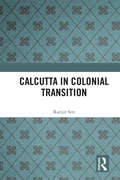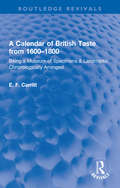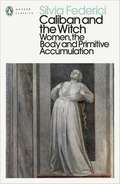- Table View
- List View
Calculation and Morality: The Costs of Slavery and the Value of Emancipation in the French Antilles (Oxford Studies in History of Economics)
by Caroline Oudin-Bastide Philippe SteinerDebates about whether to maintain or abolish slavery revolved around two key values: the morality of enslaving other human beings and the economic benefits and costs of slavery as compared to free labor. Various and conflicting arguments were presented by abolitionists, colonists, and administrators in slave-holding societies, all of whom used calculations about the relative cost and productivity of slavery to defend their own point of view in an impassioned debate. In Calculation and Morality, Caroline Oudin-Bastide and Philippe Steiner consider how economic calculations, estimations, and arguments informed the long debate over French slavery between 1771 and 1848. They show how calculation was introduced into moral debate and became a critical social object in regard both to its consistency and its manifest effects. To do so they trace a process in which phenomena were classified into groups, becoming a category, and then how metrics and calculations were used to analyze the possible effects of emancipating slaves in French colonies. Abolitionists sought to demonstrate that it was in the interest of slaveowners and/or the entire nation to employ free labour in the colonies, and to show the irrationality of the colonial and metropolitan defenders of servitude; their aim was to enlighten various parties as to their real interest, and how that real interest coincided with justice. In turn, colonists accused those opposed to slavery of being blinded by their own philanthropic principles and insisted on the rationality of the slave system as the only means of meeting the interests of everyone, including slaves, at least in the short and medium term. Oudin-Bastide and Steiner closely examine the positions and reasoning of such influential French thinkers as Pierre Samuel Du Pont de Nemours, Anne Robert Jacques Turgot, Antoine Nicolas de Condorcet, Simonde de Sismondi, Jean Baptiste Say, and Alexis de Tocqueville. In doing so they shed light on the interaction of moral precepts and econonomic calculations in a trenchant study in the history of ideas.
Calculation and Morality: The Costs of Slavery and the Value of Emancipation in the French Antilles (Oxford Studies in History of Economics)
by Philippe Steiner Caroline Oudin-BastideDebates about whether to maintain or abolish slavery revolved around two key values: the morality of enslaving other human beings and the economic benefits and costs of slavery as compared to free labor. Various and conflicting arguments were presented by abolitionists, colonists, and administrators in slave-holding societies, all of whom used calculations about the relative cost and productivity of slavery to defend their own point of view in an impassioned debate. In Calculation and Morality, Caroline Oudin-Bastide and Philippe Steiner consider how economic calculations, estimations, and arguments informed the long debate over French slavery between 1771 and 1848. They show how calculation was introduced into moral debate and became a critical social object in regard both to its consistency and its manifest effects. To do so they trace a process in which phenomena were classified into groups, becoming a category, and then how metrics and calculations were used to analyze the possible effects of emancipating slaves in French colonies. Abolitionists sought to demonstrate that it was in the interest of slaveowners and/or the entire nation to employ free labour in the colonies, and to show the irrationality of the colonial and metropolitan defenders of servitude; their aim was to enlighten various parties as to their real interest, and how that real interest coincided with justice. In turn, colonists accused those opposed to slavery of being blinded by their own philanthropic principles and insisted on the rationality of the slave system as the only means of meeting the interests of everyone, including slaves, at least in the short and medium term. Oudin-Bastide and Steiner closely examine the positions and reasoning of such influential French thinkers as Pierre Samuel Du Pont de Nemours, Anne Robert Jacques Turgot, Antoine Nicolas de Condorcet, Simonde de Sismondi, Jean Baptiste Say, and Alexis de Tocqueville. In doing so they shed light on the interaction of moral precepts and econonomic calculations in a trenchant study in the history of ideas.
The Calculus Gallery: Masterpieces from Newton to Lebesgue
by William DunhamMore than three centuries after its creation, calculus remains a dazzling intellectual achievement and the gateway into higher mathematics. This book charts its growth and development by sampling from the work of some of its foremost practitioners, beginning with Isaac Newton and Gottfried Wilhelm Leibniz in the late seventeenth century and continuing to Henri Lebesgue at the dawn of the twentieth--mathematicians whose achievements are comparable to those of Bach in music or Shakespeare in literature. William Dunham lucidly presents the definitions, theorems, and proofs. "Students of literature read Shakespeare; students of music listen to Bach," he writes. But this tradition of studying the major works of the "masters" is, if not wholly absent, certainly uncommon in mathematics. This book seeks to redress that situation. Like a great museum, The Calculus Gallery is filled with masterpieces, among which are Bernoulli's early attack upon the harmonic series (1689), Euler's brilliant approximation of pi (1779), Cauchy's classic proof of the fundamental theorem of calculus (1823), Weierstrass's mind-boggling counterexample (1872), and Baire's original "category theorem" (1899). Collectively, these selections document the evolution of calculus from a powerful but logically chaotic subject into one whose foundations are thorough, rigorous, and unflinching--a story of genius triumphing over some of the toughest, most subtle problems imaginable. Anyone who has studied and enjoyed calculus will discover in these pages the sheer excitement each mathematician must have felt when pushing into the unknown. In touring The Calculus Gallery, we can see how it all came to be.
The Calculus Gallery: Masterpieces from Newton to Lebesgue
by William DunhamMore than three centuries after its creation, calculus remains a dazzling intellectual achievement and the gateway into higher mathematics. This book charts its growth and development by sampling from the work of some of its foremost practitioners, beginning with Isaac Newton and Gottfried Wilhelm Leibniz in the late seventeenth century and continuing to Henri Lebesgue at the dawn of the twentieth--mathematicians whose achievements are comparable to those of Bach in music or Shakespeare in literature. William Dunham lucidly presents the definitions, theorems, and proofs. "Students of literature read Shakespeare; students of music listen to Bach," he writes. But this tradition of studying the major works of the "masters" is, if not wholly absent, certainly uncommon in mathematics. This book seeks to redress that situation. Like a great museum, The Calculus Gallery is filled with masterpieces, among which are Bernoulli's early attack upon the harmonic series (1689), Euler's brilliant approximation of pi (1779), Cauchy's classic proof of the fundamental theorem of calculus (1823), Weierstrass's mind-boggling counterexample (1872), and Baire's original "category theorem" (1899). Collectively, these selections document the evolution of calculus from a powerful but logically chaotic subject into one whose foundations are thorough, rigorous, and unflinching--a story of genius triumphing over some of the toughest, most subtle problems imaginable. Anyone who has studied and enjoyed calculus will discover in these pages the sheer excitement each mathematician must have felt when pushing into the unknown. In touring The Calculus Gallery, we can see how it all came to be.
The Calculus Gallery: Masterpieces from Newton to Lebesgue (Princeton Science Library #60)
by William DunhamMore than three centuries after its creation, calculus remains a dazzling intellectual achievement and the gateway to higher mathematics. This book charts its growth and development by sampling from the work of some of its foremost practitioners, beginning with Isaac Newton and Gottfried Wilhelm Leibniz in the late seventeenth century and continuing to Henri Lebesgue at the dawn of the twentieth. Now with a new preface by the author, this book documents the evolution of calculus from a powerful but logically chaotic subject into one whose foundations are thorough, rigorous, and unflinching—a story of genius triumphing over some of the toughest, subtlest problems imaginable. In touring The Calculus Gallery, we can see how it all came to be.
The Calculus Gallery: Masterpieces from Newton to Lebesgue (Princeton Science Library #60)
by William DunhamMore than three centuries after its creation, calculus remains a dazzling intellectual achievement and the gateway to higher mathematics. This book charts its growth and development by sampling from the work of some of its foremost practitioners, beginning with Isaac Newton and Gottfried Wilhelm Leibniz in the late seventeenth century and continuing to Henri Lebesgue at the dawn of the twentieth. Now with a new preface by the author, this book documents the evolution of calculus from a powerful but logically chaotic subject into one whose foundations are thorough, rigorous, and unflinching—a story of genius triumphing over some of the toughest, subtlest problems imaginable. In touring The Calculus Gallery, we can see how it all came to be.
Calculus in Context: Background, Basics, and Applications
by Alexander J. HahnBreaking the mold of existing calculus textbooks, Calculus in Context draws students into the subject in two new ways. Part I develops the mathematical preliminaries (including geometry, trigonometry, algebra, and coordinate geometry) within the historical frame of the ancient Greeks and the heliocentric revolution in astronomy. Part II starts with comprehensive and modern treatments of the fundamentals of both differential and integral calculus, then turns to a wide-ranging discussion of applications. Students will learn that core ideas of calculus are central to concepts such as acceleration, force, momentum, torque, inertia, and the properties of lenses. Classroom-tested at Notre Dame University, this textbook is suitable for students of wide-ranging backgrounds because it engages its subject at several levels and offers ample and flexible problem set options for instructors. Parts I and II are both supplemented by expansive Problems and Projects segments. Topics covered in the book include:;€¢ the basics of geometry, trigonometry, algebra, and coordinate geometry and the historical, scientific agenda that drove their development;€¢ a brief, introductory calculus from the works of Newton and Leibniz;€¢ a modern development of the essentials of differential and integral calculus;€¢ the analysis of specific, relatable applications, such as the arc of the George Washington Bridge; the dome of the Pantheon; the optics of a telescope; the dynamics of a bullet; the geometry of the pseudosphere; the motion of a planet in orbit; and the momentum of an object in free fall.Calculus in Context is a compelling exploration;¢;‚¬;€?for students and instructors alike;¢;‚¬;€?of a discipline that is both rich in conceptual beauty and broad in its applied relevance.
Calculus in Context: Background, Basics, and Applications
by Alexander J. HahnBreaking the mold of existing calculus textbooks, Calculus in Context draws students into the subject in two new ways. Part I develops the mathematical preliminaries (including geometry, trigonometry, algebra, and coordinate geometry) within the historical frame of the ancient Greeks and the heliocentric revolution in astronomy. Part II starts with comprehensive and modern treatments of the fundamentals of both differential and integral calculus, then turns to a wide-ranging discussion of applications. Students will learn that core ideas of calculus are central to concepts such as acceleration, force, momentum, torque, inertia, and the properties of lenses. Classroom-tested at Notre Dame University, this textbook is suitable for students of wide-ranging backgrounds because it engages its subject at several levels and offers ample and flexible problem set options for instructors. Parts I and II are both supplemented by expansive Problems and Projects segments. Topics covered in the book include:;€¢ the basics of geometry, trigonometry, algebra, and coordinate geometry and the historical, scientific agenda that drove their development;€¢ a brief, introductory calculus from the works of Newton and Leibniz;€¢ a modern development of the essentials of differential and integral calculus;€¢ the analysis of specific, relatable applications, such as the arc of the George Washington Bridge; the dome of the Pantheon; the optics of a telescope; the dynamics of a bullet; the geometry of the pseudosphere; the motion of a planet in orbit; and the momentum of an object in free fall.Calculus in Context is a compelling exploration;¢;‚¬;€?for students and instructors alike;¢;‚¬;€?of a discipline that is both rich in conceptual beauty and broad in its applied relevance.
The Calculus of Violence: How Americans Fought the Civil War
by Aaron Sheehan-DeanDiscarding tidy abstractions about the conduct of war, Aaron Sheehan-Dean shows that the notoriously bloody US Civil War could have been much worse. Despite agonizing debates over Just War and careful differentiation among victims, Americans could not avoid living with the contradictions inherent in a conflict that was both violent and restrained.
Calculus Reordered: A History of the Big Ideas
by David M. BressoudHow our understanding of calculus has evolved over more than three centuries, how this has shaped the way it is taught in the classroom, and why calculus pedagogy needs to changeCalculus Reordered takes readers on a remarkable journey through hundreds of years to tell the story of how calculus evolved into the subject we know today. David Bressoud explains why calculus is credited to seventeenth-century figures Isaac Newton and Gottfried Leibniz, and how its current structure is based on developments that arose in the nineteenth century. Bressoud argues that a pedagogy informed by the historical development of calculus represents a sounder way for students to learn this fascinating area of mathematics.Delving into calculus’s birth in the Hellenistic Eastern Mediterranean—particularly in Syracuse, Sicily and Alexandria, Egypt—as well as India and the Islamic Middle East, Bressoud considers how calculus developed in response to essential questions emerging from engineering and astronomy. He looks at how Newton and Leibniz built their work on a flurry of activity that occurred throughout Europe, and how Italian philosophers such as Galileo Galilei played a particularly important role. In describing calculus’s evolution, Bressoud reveals problems with the standard ordering of its curriculum: limits, differentiation, integration, and series. He contends that the historical order—integration as accumulation, then differentiation as ratios of change, series as sequences of partial sums, and finally limits as they arise from the algebra of inequalities—makes more sense in the classroom environment.Exploring the motivations behind calculus’s discovery, Calculus Reordered highlights how this essential tool of mathematics came to be.
The Calculus Wars: Newton, Leibniz, and the Greatest Mathematical Clash of All Time
by Jason Socrates BardiThis vibrant and gripping history ultimately exposes how these twin mathematical giants (Newton, Leibniz) were proud, brilliant, at times mad, and in the end completely human.
Calcutta
by Geoffrey MoorhouseIn the foreword to the first edition Geoffrey Moorhouse wrote:'In a sense, the story of Calcutta is the story of India . . . It is the story of how and why Empire was created and what happened when Empire finished . . . The imperial residue of Calcutta, a generation after Empire ended, is both a monstrous and a marvellous city. Journalism and television have given us a rough idea of the monstrosities but none at all of the marvels. I can only hope to define the first more clearly and to persuade anyone interested that the second is to be found there too'. Geoffrey Moorhouse succeeds triumphantly in his aims. First published in 1971 this title has stood the test of time. Remarkably it was the first full-length study of Calcutta, seat of the British Raj, since 1918.'The book is organized out of a profound understanding of the true issues and is brilliantly executed.' Paul Scott, Guardian
Calcutta: The Stormy Decades
by Tanika Sarkar Sekhar BandyopadhyayPolitics and culture are organically related in the city of Calcutta. The period (1940s to 1950s), was chaotic and turbulent, yet, this was also a time of significant creativity in literature, art, films and music in the city. This is an unusual feature of any city but is interestingly characteristic of Calcutta. The originality of the work lies in blending poetry with historical writing, retaining the essence of both forms against the backdrop of the tumultuous events of the critical decades, as against the entire historical period of a city. This historical method together with twenty-one papers give the reader a sense of the pulse of this complex city ‘emerging creatively and chaotically from its colonial past’.
Calcutta: The Stormy Decades
by Tanika Sarkar Sekhar BandyopadhyayPolitics and culture are organically related in the city of Calcutta. The period (1940s to 1950s), was chaotic and turbulent, yet, this was also a time of significant creativity in literature, art, films and music in the city. This is an unusual feature of any city but is interestingly characteristic of Calcutta. The originality of the work lies in blending poetry with historical writing, retaining the essence of both forms against the backdrop of the tumultuous events of the critical decades, as against the entire historical period of a city. This historical method together with twenty-one papers give the reader a sense of the pulse of this complex city ‘emerging creatively and chaotically from its colonial past’.
Calcutta in Colonial Transition
by Ranjit SenThis book brings home the story of how three clustered villages grew into a primate city, in which a garrison town, a port city and the capital of an empire merged into one entity—Calcutta. This and its companion volume Birth of a Colonial City examine the geopolitical factors that were significant in securing Calcutta's position in the light of growing influence of the East India Company and subsequently the British Empire. A definitive history of Calcutta in its nascent years, this book discusses the challenges of city-planning, the de-industrialization at the hands of British imperialists, the catastrophic fall of the Union Bank, the advent of British capital, and the rise of the Bengali business enterprise in the colonial era. It also underlines how Calcutta facilitated the development of a political consciousness and the pivotal political and cultural role it played when the movement for independence took hold in the country. This volume will be of great interest to scholars and researchers of modern South Asian history, British Studies, city and area studies.
Calcutta in Colonial Transition
by Ranjit SenThis book brings home the story of how three clustered villages grew into a primate city, in which a garrison town, a port city and the capital of an empire merged into one entity—Calcutta. This and its companion volume Birth of a Colonial City examine the geopolitical factors that were significant in securing Calcutta's position in the light of growing influence of the East India Company and subsequently the British Empire. A definitive history of Calcutta in its nascent years, this book discusses the challenges of city-planning, the de-industrialization at the hands of British imperialists, the catastrophic fall of the Union Bank, the advent of British capital, and the rise of the Bengali business enterprise in the colonial era. It also underlines how Calcutta facilitated the development of a political consciousness and the pivotal political and cultural role it played when the movement for independence took hold in the country. This volume will be of great interest to scholars and researchers of modern South Asian history, British Studies, city and area studies.
Caleb’s Crossing (Playaway Adult Fiction Ser.)
by Geraldine BrooksA novel from Pulitzer Prize-winner Geraldine Brooks, author of the Richard and Judy bestseller ‘March’, ‘Year of Wonders’ and ‘People of the Book’.
The Caledonian Canal: In The Great Glen
by A.D. CameronThomas Telford's plan, to connect Loch Ness, Loch Oich and Loch Lochy with each other and the sea, was a huge undertaking which brought civil engineering to the Highlands on a heroic scale. Deep in the Highlands, far from the canal network of England, engineers forged their way through the Great Glen to construct the biggest canal of its day: twenty-two miles of artificial cutting and no fewer than twenty-eight locks. This book has long been recognised as the authoritative work on the canal as well as a reliable and useful guide to the surrounding area. There are intriguing old plans, not discovered until 1992, and a survey of the dramatic rise in pleasure-craft traffic during the last two decades. But the highlight of the recent past was undoubtedly the Tall Ships passing through the canal in stately procession in 1991. Impossible, then, not to feel the fascination of this beautiful waterway: a working piece of industrial history and a remarkable engineering achievement. This book is a fitting celebration of this remarkable feat of engineering.
A Calendar of British Taste from 1600–1800: Being a Museum of Specimens & Landmarks Chronologically Arranged (Routledge Revivals)
by E. F. CarrittFirst published in 1948, A Calendar of British Taste from 1600–1800 gives a picture of British taste in art, nature and manners during the centuries 1600 to 1800. The book is an anthology from novels, poetry, letters, essays, advertisements and diaries of the period. It is arranged chronologically and covers a wide range of topics including architecture, gardens, manners, music, nature, painting, poetry, sculpture, and the stage. Key authors drawn upon include Pepys, Dryden, Pope, Horace Walpole, Dr. Johnson, Fanny Burney, Cowper, and Wordsworth. Through an extensive and panoramic view, the book traces the development and changes in taste over time. A Calendar of British Taste from 1600–1800 is ideal for anyone with an interest in the cultural and social history of Britain.
A Calendar of British Taste from 1600–1800: Being a Museum of Specimens & Landmarks Chronologically Arranged (Routledge Revivals)
by E. F. CarrittFirst published in 1948, A Calendar of British Taste from 1600–1800 gives a picture of British taste in art, nature and manners during the centuries 1600 to 1800. The book is an anthology from novels, poetry, letters, essays, advertisements and diaries of the period. It is arranged chronologically and covers a wide range of topics including architecture, gardens, manners, music, nature, painting, poetry, sculpture, and the stage. Key authors drawn upon include Pepys, Dryden, Pope, Horace Walpole, Dr. Johnson, Fanny Burney, Cowper, and Wordsworth. Through an extensive and panoramic view, the book traces the development and changes in taste over time. A Calendar of British Taste from 1600–1800 is ideal for anyone with an interest in the cultural and social history of Britain.
Calendar of Crime: 365 True Cases from British History
by Peter Stubley* 19 May 1536: Anne Boleyn, charged with high treason, is beheaded at the Tower of London * 31 August 1888: Mary Ann Nichols, the first victim of Jack the Ripper, is found murdered in Buck’s Row * 18 December 1914: George Joseph Smith murders his wife in a Blackpool boarding house bath, sparking the police investigation that finally ended his killing spree * 13 August 1964: Peter Allen and Gwynne Owen Evans go to the gallows, the last two men to be executed in the UK This volume contains 365 amazing and incredible true crimes from British history. With infamous names – Crippen, Seddon, Haigh, Ellis – alongside lesser-known examples from the British pantheon of crime, it will fascinate and unnerve readers everywhere.
Calendars in the Dead Sea Scrolls: Measuring Time (The Literature of the Dead Sea Scrolls)
by James C. VanderKam1997 was the 50th anniversary of the discovery of the Dead Sea Scrolls. Calendars in the Dead Sea Scrolls explores the evidence about calendars in the Dead Sea Scrolls, the Hebrew Bible and other ancient Jewish texts. James C. VanderKam examines the pertinent texts, their sources and the different uses to which people put calendrical information in the Christian world.Calendars in the Dead Sea Scrolls provides a valuable addition to the Dead Sea Scrolls Series and contributes to the elucidation of the scroll texts themselves and their relation to other Biblical texts.
Calendars in the Dead Sea Scrolls: Measuring Time (The Literature of the Dead Sea Scrolls)
by James C. VanderKam1997 was the 50th anniversary of the discovery of the Dead Sea Scrolls. Calendars in the Dead Sea Scrolls explores the evidence about calendars in the Dead Sea Scrolls, the Hebrew Bible and other ancient Jewish texts. James C. VanderKam examines the pertinent texts, their sources and the different uses to which people put calendrical information in the Christian world.Calendars in the Dead Sea Scrolls provides a valuable addition to the Dead Sea Scrolls Series and contributes to the elucidation of the scroll texts themselves and their relation to other Biblical texts.
The Calhoun Chronicles Bundle: The Charm School - The Horsemaster's Daughter - Halfway To Heaven (The\calhoun Chronicles Ser. #1)
by Susan WiggsAward-winning New York Times bestseller and consummate storyteller Susan Wiggs brings you three enthralling historical romances about unconventional women and the men who learn to love them. Included in this bundle are The Charm School, The Horse master's Daughter and Halfway to Heaven.
Caliban and the Witch: Women, the Body and Primitive Accumulation (Penguin Modern Classics)
by Silvia Federici'A groundbreaking work . . . Federici has become a crucial figure for . . . a new generation of feminists' Rachel Kushner, author of The Mars RoomA cult classic since its publication in the early years of this century, Caliban and the Witch is Silvia Federici's history of the body in the transition to capitalism. Moving from the peasant revolts of the late Middle Ages through the European witch-hunts, the rise of scientific rationalism and the colonisation of the Americas, it gives a panoramic account of the often horrific violence with which the unruly human material of pre-capitalist societies was transformed into a set of predictable and controllable mechanisms. It Is a study of indigenous traditions crushed, of the enclosure of women's reproductive powers within the nuclear family, and of how our modern world was forged in blood.'Rewarding . . . allows us to better understand the intimate relationship between modern patriarchy, the rise of the nation state and the transition from feudalism to capitalism' Guardian



